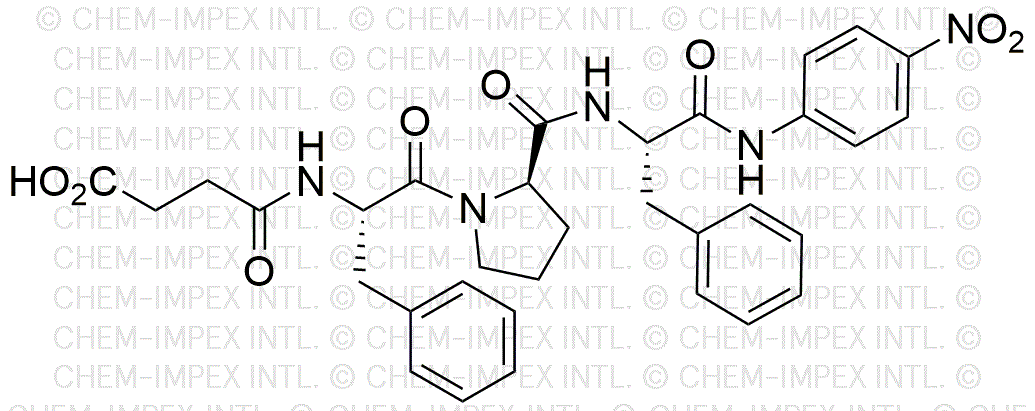Suc-Phe-Pro-Phe-pNA is widely utilized in research focused on:
- Enzyme Activity Assays: This compound serves as a substrate in enzyme assays, particularly for studying proteases. Its ability to release a measurable product upon enzymatic cleavage makes it valuable for quantifying enzyme activity in various biological samples.
- Drug Development: In pharmaceutical research, it is used to evaluate the efficacy of new drugs targeting proteolytic enzymes. By understanding how these enzymes interact with the compound, researchers can design better inhibitors or activators.
- Biochemical Research: It plays a crucial role in studying protein interactions and modifications. Researchers can use it to investigate how different proteins interact in cellular processes, which is essential for understanding disease mechanisms.
- Diagnostic Applications: The compound can be incorporated into diagnostic tests for diseases involving protease activity, such as certain cancers or viral infections, providing a means for early detection and monitoring.
- Education and Training: Suc-Phe-Pro-Phe-pNA is often used in academic settings to teach students about enzyme kinetics and protein chemistry, providing hands-on experience with real-world applications in biochemistry.
General Information
Properties
Safety and Regulations
Applications
Suc-Phe-Pro-Phe-pNA is widely utilized in research focused on:
- Enzyme Activity Assays: This compound serves as a substrate in enzyme assays, particularly for studying proteases. Its ability to release a measurable product upon enzymatic cleavage makes it valuable for quantifying enzyme activity in various biological samples.
- Drug Development: In pharmaceutical research, it is used to evaluate the efficacy of new drugs targeting proteolytic enzymes. By understanding how these enzymes interact with the compound, researchers can design better inhibitors or activators.
- Biochemical Research: It plays a crucial role in studying protein interactions and modifications. Researchers can use it to investigate how different proteins interact in cellular processes, which is essential for understanding disease mechanisms.
- Diagnostic Applications: The compound can be incorporated into diagnostic tests for diseases involving protease activity, such as certain cancers or viral infections, providing a means for early detection and monitoring.
- Education and Training: Suc-Phe-Pro-Phe-pNA is often used in academic settings to teach students about enzyme kinetics and protein chemistry, providing hands-on experience with real-world applications in biochemistry.
Documents
Safety Data Sheets (SDS)
The SDS provides comprehensive safety information on handling, storage, and disposal of the product.
Product Specification (PS)
The PS provides a comprehensive breakdown of the product’s properties, including chemical composition, physical state, purity, and storage requirements. It also details acceptable quality ranges and the product's intended applications.
Certificates of Analysis (COA)
Search for Certificates of Analysis (COA) by entering the products Lot Number. Lot and Batch Numbers can be found on a product’s label following the words ‘Lot’ or ‘Batch’.
Numéro de catalogue
Numéro de lot/série
Certificates Of Origin (COO)
This COO confirms the country where the product was manufactured, and also details the materials and components used in it and whether it is derived from natural, synthetic, or other specific sources. This certificate may be required for customs, trade, and regulatory compliance.
Numéro de catalogue
Numéro de lot/série
Safety Data Sheets (SDS)
The SDS provides comprehensive safety information on handling, storage, and disposal of the product.
DownloadProduct Specification (PS)
The PS provides a comprehensive breakdown of the product’s properties, including chemical composition, physical state, purity, and storage requirements. It also details acceptable quality ranges and the product's intended applications.
DownloadCertificates of Analysis (COA)
Search for Certificates of Analysis (COA) by entering the products Lot Number. Lot and Batch Numbers can be found on a product’s label following the words ‘Lot’ or ‘Batch’.
Numéro de catalogue
Numéro de lot/série
Certificates Of Origin (COO)
This COO confirms the country where the product was manufactured, and also details the materials and components used in it and whether it is derived from natural, synthetic, or other specific sources. This certificate may be required for customs, trade, and regulatory compliance.

